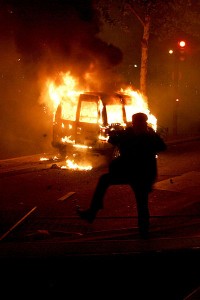The emerging logic of looting and why the police couldn’t deal with it
By Orit Gal
Over the last four nights London has been plagued by a new phenomenon daubed as “recreational looting”. Moving like swarms between sporadic high streets, teenage boys and girls rampaged their way into “electric and trainers heaven”. Dispersed police forces could only watch these almost apocalyptic scenes from the sidelines, appearing to lack the strategic and tactical capacities to prevent the next swarm.
So what went wrong? A complexity perspective reveals how the systemic nature of rioting transformed on Friday night, thus presenting a new logic of operation which is very different than the one riot police forces are trained for.
Common incidents of rioting, whether in the UK or other places across the world, have tended to follow a familiar pattern – local protests, driven by political or personal grievances escalating into violent and vandalising behaviour. Whatever the background or catalyzing process, the logic shaping behaviour on the ground is one of friction between rioters and police. As rioters seek to provoke a clash with the police, the police seek to contain and/or deter such clashes.
Under such circumstances, the police itself becomes the “attractor” of the system, with rioters adapting their behaviour to police positioning and confrontational tactics. Police forces’ strategy thus relies on their ability to shape events on the ground through a spectrum of tactics from escalation and deterrence to containment and absorption. But an underlying characteristic is that there is a “co-evolving” relationship between the rioters and the police.
Initially, Friday night’s events in Tottenham reflected this exact pattern. With the police choosing a containment tactic, based on the logic of minimizing friction while waiting for the rioters to vent their anger.
However as events spread to other areas on Saturday, i.e. during the replication process – a mutation occurred in the underlying logic of this system. The logic no longer seemed to be about friction but about opportunistic looting. Rioters did not seek police attention, rather they took advantage of its absence. The police thus lost their position as the system’s attractor, thereby losing their strategic basis.
Within the huge and complex urban space, the loss of a clear rationale for the rioters’ physical positioning, meant the police could merely retreat to sporadic cats and mice games, with the mice clearly having the advantage. How this story ends will depend on the police’s ability to learn through action and adapt their strategies and tactics to the new logic of their opponent.
Much will be explored over the next days, weeks and months as to the underlying causes of these horrendous events with vested agents framing them through their own political narratives. The “system” might prove fragile, and get much worse; or it might prove robust, and things quieten down. We simply cannot predict which it will be. As experts, we should make sure that such explorations and their policy implications will not be reduced to simple cause-effect relations, but would rather consider the dynamic processes and permissive conditions that enable such systemic emergences, thereby laying the ground for new preventative social and policing infrastructures.

I see David Cameron is inviting former Los Angeles Police chief William Bratton to act as a special advisor to the British police, help them implement a zero tolerance policy towards the rioters. What nonsense. Maybe we should send our police over to Los Angeles, help them get their murder rate down to something like what ours is – anybody ever consider that?